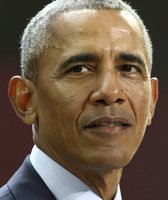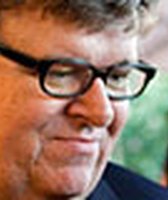Stand up for the facts!
Our only agenda is to publish the truth so you can be an informed participant in democracy.
We need your help.
I would like to contribute
Obama claims U.S. has doubled production of 'clean energy'
America’s recovery from the Great Recession is slow but steady, President Barack Obama said in a recent speech, and the country is headed in the right direction, thanks in part to his energy initiatives.
He told students at Pellissippi State Community College in Knoxville, Tenn., on Jan. 9, 2015, the United States is now the world’s No. 1 producer in oil and gas -- a statement we’ve researched in the past and rated True -- and touted a move to more renewable resources.
"We’ve doubled the production of clean energy," Obama told the crowd.
There was no time frame given or any indication of what he considered clean energy, but PolitiFact wondered whether that was true. And if it was, could he take credit for it?
Generating interest
The White House specified Obama was referring to solar, wind and geothermal (harnessing power from heat generated under the Earth’s crust), but omitted any specific time frame. We can go ahead and assume they mean since the beginning of Obama’s first term, but the definition of renewables needs some explaining.
The U.S. Energy Information Administration considers renewable energy as coming from any source that is "naturally replenishing but flow-limited," meaning there are limits on how much energy can be derived from the source at once.
This also includes biomass fuels, like burning wood and solid waste, and hydroelectric power. States often don’t classify hydroelectric as renewable for several reasons, including substantial infrastructure requirements and the disruption of water ecosystems. Many states also don’t count hydroelectric in order to pressure utilities to increase renewable energy resources beyond existing hydroelectric facilities.
It’s important to note that promoting renewable energy was a major focus of the American Recovery and Reinvestment Act passed by the Democrat-controlled Congress in February 2009 to help spur the economy in the wake of the recession. Obama signed the bill, which contained some $90 billion for energy-related investment, reimbursements for installations, a reauthorized loan guarantee program and tax credits. One of the goals was to double renewable energy generation by 2012.
Since the administration mentioned those three energy sources as their definition of "clean energy," they are the ones we asked the Energy Information Administration about. Spokesperson John Cogan provided this information for the existing net summer capacity of energy production types in megawatts:
Year
Wind
Solar, Thermal and Photovoltaic
Geothermal
Total
2007
16,515
502
2,214
19,231
2008
24,651
536
2,229
27,416
Featured Fact-check
2009
34,296
619
2,382
37,297
2010
39,135
866
2,405
42,406
2011
45,676
1,524
2,409
49,609
2012
59,075
3,170
2,592
65,377
Now, don’t go thinking we’re all suddenly living emission-free and the specter of global warming due to greenhouse gases is a thing of the past. The country still uses fossil fuels like coal, petroleum and natural gas for most of its electricity needs, about 68 percent as of June 2014 (the EIA says wind, solar and geothermal generated less than 5 percent in that time frame, up from about 1.5 percent in 2008). Still, that’s a marked decrease in fossil fuel use, which was around 85 percent in 2008.
Also, we can’t completely ignore hydroelectric and biomass sources. Those sources are considered renewable even if they weren’t named by the White House, but their use has not doubled since 2008. Both have remained basically flat in that time period.
So can Obama take credit for this spike in renewable energy resource use? Joseph Aldy, former special assistant to the president for energy and environment in 2009-10 and currently an assistant public policy professor at Harvard, says yes, arguing the combination of tax credits, grants and guaranteed loans for renewable energy projects helped boost providers through tight credit and labor markets. Current production far exceeds Energy Information Administration projections from 2009, he told PolitiFact.
Susan Glickman, the Florida director of the pro-renewables Southern Alliance for Clean Energy said some expansion would have happened anyway, since costs have gone down, particularly for wind and solar. But not only did the Recovery Act spur growth for renewable energy, the residual effects have continued. The 2013 National Renewable Energy Laboratory report bears out these growth trends, which have been fueled by federal incentives, she said.
Our ruling
Obama said, "we’ve doubled the production of clean energy."
The White House said he was referring to wind, solar and geothermal, which are three types of renewable resources promoted in the American Recovery and Reinvestment Act of 2009. The Energy Information Administration confirmed that capacity had basically doubled between 2009 and 2012, accomplishing Obama’s goals. Renewable resource advocates also agreed that the Recovery Act contributed to that growth.
Obama didn’t mention, however, that so-called "clean energy" still accounts for a sliver of U.S. energy production, which overwhelmingly relies on fossil fuels. Nor does it include other kinds of renewable energy, such as biomass and hydroelectric, which have remained relatively flat.
We rate the statement Mostly True.
Our Sources
White House, "Remarks by the President on America's College Promise," Jan. 9, 2015
Resources For the Future, "A Preliminary Review of the American Recovery and Reinvestment Act’s Clean Energy Package," January 2012
U.S. Department of Energy, "Successes of the Recovery Act," January 2012
Midwest Energy News, "Renewable or not? How states count hydropower," Jan. 13, 2012
KQED News, "Reality Check: California’s Ultra-Low-Greenhouse Gas Future," Sept. 27, 2012
National Renewable Energy Laboratory, "Status and Trends in the U.S. Voluntary Green Power Market (2012 Data)," October 2013
Governing.com, "Is Hydropower a Renewable Energy or Not?," September 2013
Pew Research Center, "Powered by oil and gas, U.S. energy production is on the rise," Sept. 26, 2013
U.S. Energy Information Administration, "What is U.S. electricity generation by energy source?," June 13, 2014
U.S. Department of Energy, "2013 Renewable Energy Data Book," December 2014
U.S. Energy Information Administration, "Monthly Energy Review Table 7.2a," December 2014
U.S. Energy Information Administration, "Monthly Energy Review Table 10.1," December 2014
PolitiFact.com, "Klobuchar says U.S. is world's No. 1 oil producer," Jan. 4, 2015
The National Academies, "What you need to know about energy: Renewable sources," accessed Jan. 19, 2015
The National Academies, "What you need to know about energy: Energy sources," accessed Jan. 19, 2015
Recovery.gov, "Breakdown of Funding," accessed Jan. 19, 2015
Center for Climate and Energy Solutions, "Energy Sources (2010)," accessed Jan. 19, 2015
Center for Climate and Energy Solutions, "Renewable Energy," accessed Jan. 19, 2015
U.S. Department of the Treasury, "1603 Program: Payments for Specified Energy Property in Lieu of Tax Credits," accessed Jan. 19, 2015
U.S. Department of Energy, "Section 1705 Loan Program," accessed Jan. 19, 2015
U.S. Department of Energy, "Recovery Act: Smart Grid Investment Grants," accessed Jan. 19, 2015
U.S. Department of Energy, "Recovery Act," accessed Jan. 19, 2015
U.S. Energy Information Administration, "Annual Electric Generator Report: Existing Net Summer Capacity of Other Renewable Sources by Producer Type, 2002 through 2012 (Megawatts)," accessed Jan. 19, 2015
Interview with Frank Benenati, White House spokesperson, Jan. 15, 2015
Interview with Jonathan Cogan, U.S. Energy Information spokesperson, Jan. 16, 2015
Interview with Joseph Aldy, Harvard University assistant public policy professor, Jan. 16, 2015
Interview with Susan Glickman, Florida director of Southern Alliance for Clean Energy, Jan. 19, 2015
Browse the Truth-O-Meter
More by Joshua Gillin
Obama claims U.S. has doubled production of 'clean energy'
Support independent fact-checking.
Become a member!
In a world of wild talk and fake news, help us stand up for the facts.






































